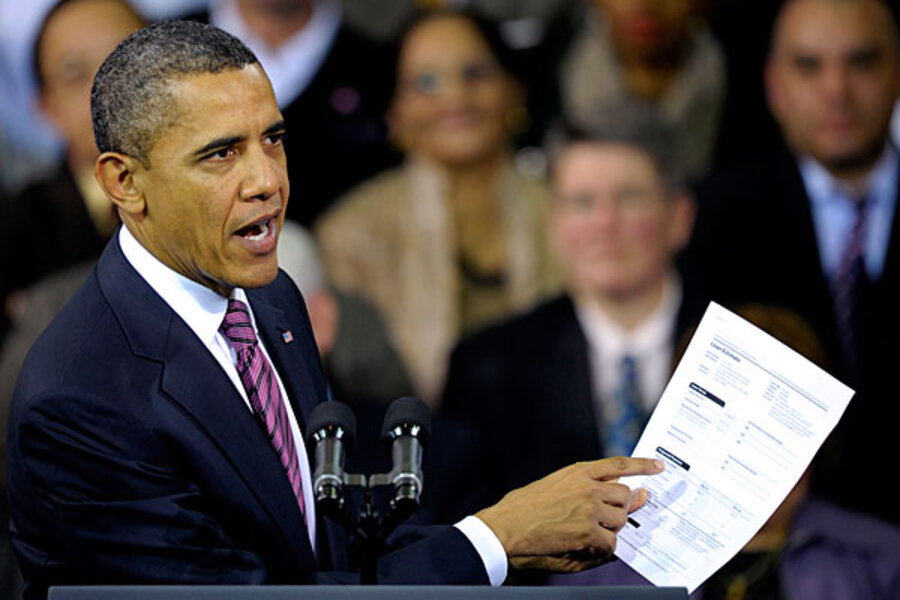Obama plan to lower mortgage payments could help, but how much?
Loading...
President Obama fleshed out a new mortgage-relief plan Wednesday, saying the steps he outlines would "help millions of responsible homeowners" and the US economy.
The proposal aims to bring lower monthly mortgage payments to as many borrowers as possible.
A key element: Where past refinancing initiatives have focused especially on Americans with so-called "conforming" loans backed by Fannie Mae or Freddie Mac, Mr. Obama is hoping to extend similar relief to loans underwritten by private lenders.
Millions of households hold these loans, and a refinance at today's low interest rates can bring savings of $300 per month for typical families. More than one-third of them have balances larger than the home's current value, which has made traditional refinancing impossible.
With the housing market still depressed, and overall consumer spirits still dampened by America's debt overhang, many economists support the pursuit of new policies to help reduce foreclosures and stabilize home values.
"It would make a difference" for the housing market and economy, says Patrick Newport, an economist at IHS Global Insight, referring to Obama's latest initiative.
But he warns against thinking that the impact of Obama's or other proposals would be enormous. Yes, the housing market and mortgage debts are central to the nation's current struggles, says Mr. Newport, who specializes in housing. But no single policy is a quick or dramatic fix.
The president, in essence, acknowledged that point in a speech Wednesday in Falls Church, Va.
"The truth is, it’s going to take more time than any of us would like for the housing market to fully recover from this crisis," Obama said as he unveiled details of new initiatives. "I’ll be honest – the programs that we put forward [so far] haven’t worked at the scale that we hoped."
He said his administration's efforts have helped nearly 1 million people refinance in the past two years. But the scale of the problem is massive.
The nation now has about 30 million mortgages backed by government-sponsored enterprises (GSEs), mainly Fannie or Freddie, Newport says. About 3 million of those are "under water," meaning the loan is now bigger than home value. Another 20 million or more have been underwritten entirely by private lenders. Some 35 percent of those, 7 million or more, are under water.
Obama's argument is that as more families refinance at a low interest rate, incidences of default and foreclosure will diminish, helping to stabilize home values and restore consumer confidence. The families who benefit will also get extra cash in their pockets each month, which they can use to buy other things in the economy or to pay down debt.
The president's latest plan includes several major elements:
- Allowing more borrowers with GSE-insured loans to refinance through Fannie and Freddie. Obama outlined several moves toward "streamlined refinancing."
- Creating a new refinance program for non-GSE borrowers, through the Federal Housing Administration (FHA). Costs of the program would be covered by a new Financial Crisis Responsibility Fee on banks. This program, and the fee on banks, would require congressional approval.
- As with Obama's existing "refi" program, the new one for non-GSE loans is designed to allow many underwater borrowers to benefit. Participants must live in the home and be current on the mortgage. Availability would be more limited if a loan is deeply underwater (loan more than 140 percent of home value) or if borrower is unemployed.
- A new initiative will aim to turn more foreclosed homes into rental properties. That's better, Obama said, than having lots of vacant homes in a neighborhood.
- The Consumer Financial Protection Bureau is moving to make the mortgage application process simpler and more transparent. Obama held up a single sheet of paper designed to replace what are currently overlapping and complex disclosures.
One obvious challenge to implementing Obama's new housing blueprint is that Republicans control the House of Representatives. They aren't keen to create new mortgage-relief programs or what amounts to a new tax on banks – especially for a plan that results in only a modest boost.
Even if the Obama plans could be implemented in their entirety, new foreclosures coming into the pipeline from a large pool of already-delinquent borrowers would not be eligible for the Obama relief, for example.
And if the refi boom helped 3 million households each save about $3,000 a year, the boost to the economy would still be quite small – on the order of 0.1 percent of gross domestic product, according to an estimate by Capital Economics, a research firm in Toronto.
Obama's housing pitch represents part of a broader "blueprint" for the US economy, which he laid out in his State of the Union address in January. The blueprint is partly a set of policy proposals and partly a campaign platform, designed to show voters the president trying all possible ways to lift a weak economy.
Home prices have continued to edge generally downward even after the recession ended, although the number of delinquent loans has been gradually declining over the past year. Housing analysts say its possible home prices will stabilize by later this year.





